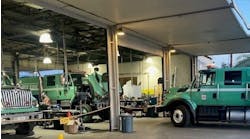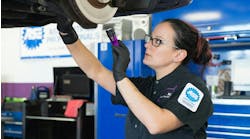We all know that pre- and post-trip inspections are the first line of defense in keeping assets on the road and in avoiding violations and fines during roadside inspections. And let’s not forget that they are mandated by the Federal Motor Carrier Safety Administration (FMCSA).
Your drivers are supposed to perform these inspections before they head out for the day and when they have completed their run for the day. It is human nature to get in a pattern when doing something routinely, sometimes going on “automatic pilot” to complete a repetitive task.
But with all fleets operating older assets, the pre- and post-trip inspections have taken on increased importance.
FMCSA has a checklist that drivers need to follow to cover key areas of the truck. It starts with checking the truck’s general condition. The driver should look for any obvious issues, note those and report any that are serious on the Driver Vehicle Inspection Report (DVIR) so that the shop can take action to correct any problems.
Next, the driver needs to check fluid levels, including engine, coolant, and transmission. They also should look at the condition of belts, hoses, wires, batteries, and all electrical connections with special attention to slipping belts, loose connections, and signs of fraying or wear on belts and hoses.
Although trailers have less complexity than trucks, they are generally much larger and more visible, plus they tend to be what the vehicle behind your driver sees first. Paying special attention to obvious telltale signs of improper maintenance, such as missing mud flaps or airlines that are not properly secured, are surefire ways to earn a pullover situation.
Inoperable lights are a big reason a Department of Transportation (DOT) inspector will pull a truck over for a roadside inspection. Drivers need to check that lights—low-beam headlights, four-way flashers, high-beam headlights, and any other lights on the tractor and the trailer—are fully operational.
Next, the driver should check all gauges and controls in the cab. During the brake inspection, drivers should determine that all brakes, including the parking and service brakes, are working properly.
The best way to ensure that the driver performs a thorough inspection is to develop an inspection form that has the driver walking around the exterior of the vehicle in a systematic way. Starting at the front left side of the truck, the driver should continue all the way around the truck.
This will help ensure that no part of the truck gets overlooked. If you have not moved to an electronic version of the pre- and post-trip inspection form, you might want to consider doing so. Allowing drivers to complete these inspections using their smartphones or tablets makes the process more efficient.
If you haven’t conducted refresher training on pre- and post-trip inspections for your driver recently, you should consider doing so. You also can gamify the inspection training process by hiding coupons to local restaurants or for company swag in key spots on the truck to see just how thorough a job your drivers are doing when inspecting their vehicles.
While a pre- or post-trip inspection seems like a simple thing, it can have a big impact on the health of your vehicles.
Gino Fontana, CTP, is COO and EVP at Transervice Logistics Inc. Prior to this, he was VP of operations at Berkeley Division and Puerto Rico. He has more than 35 years of experience in the transportation and logistics industry with both operational and sales experience.
This article originally appeared in FleetOwner.com.



